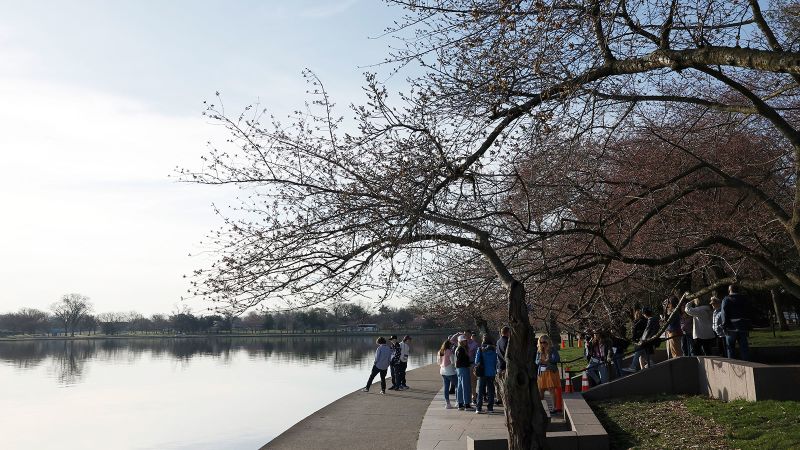The National Park Service is gearing up to remove nearly 160 cherry trees in Washington, DC, in an effort to repair the city’s deteriorating seawalls, the agency announced Wednesday.
The $113 million, three-year project is set to begin in late spring and early summer around the Tidal Basin and along the Potomac River through West Potomac Park, after the National Cherry Blossom Festival draws crowds to celebrate the district’s iconic blooms.
Roughly 300 trees are scheduled for removal in the construction zones. More than 450 trees, including 274 cherry trees, will be replanted in the area when the project is finished, the NPS said in a statement.
“One important thing to remember is yes, we’re taking down 300 trees to make this improvement, but we’re also replanting,” said Mike Litterst, a spokesperson for the National Mall and Memorial Parks. “And there will be an enormous increase in the number of trees that are out there.”
Rising sea levels and warming temperatures threaten the thousands of cherry trees in Washington, DC. Not only have the trees blossomed early in recent years, but frequent flooding and a decaying seawall around the Tidal Basin have submerged the trees’ roots, disrupting the oxygen flow that requires them to blossom.
“Trees are not equipped to handle that much water coming in,” Litterst told CNN. “Unfortunately, the only way to fix the problem is to make the sea walls higher to accommodate for expected sea level rise in the next 100 years.”
To do so, they would need to remove trees like “Stumpy,” a haggard-looking but beloved cherry tree on the south side of the Tidal Basin. Construction around the Tidal Basin will remove about 140 cherry trees between the Thomas Jefferson Memorial and the Franklin Delano Roosevelt Memorial.
The sea level in Washington, DC, has risen roughly 1.15 feet over the last century, according to data from the National Oceanic and Atmospheric Administration, and is projected to increase 2 to 6 feet by the end of the century.
While roughly a foot of sea level rise may seem insignificant, every inch puts more pressure on the river’s banks and seawalls already in place — and the impacts worsen during storms and high tide.
A recent study published in the journal Nature found that as oceans rise and coasts sink, hundreds of thousands of acres of land will be exposed to destructive flooding by 2050. Many cities on the Eastern Seaboard are at even higher risk of coastal flooding due to their lack of physical protection such as seawalls.
In this part of DC, the seawalls are not only old, but they “weren’t built well,” said Litterst.
“Portions of the seawalls have settled as much as five feet since their initial construction from the late 1800s to the early 1900s,” the NPS said in the statement. “As a result of the settling and sea level rise, water flows over portions of the seawalls twice a day during normal tidal conditions.”
The seawall repair project will be funded by the Great American Outdoors Act Legacy Restoration Fund. The Act is “part of a concerted national effort to address the extensive maintenance backlog in America’s national parks,” according to the NPS, and the fund provides the NPS with up to $1.3 billion per year for five years to make significant enhancements in national parks.
The tree removal effort comes as the annual National Cherry Blossom Festival is set to take place from March 20 to April 14, bringing crowds to the area. NPS officials say construction activity this year will not affect the event’s visitors, except for temporary pedestrian detours in some areas.
The NPS announced the repair project ahead of this year’s blossom festival in part so people could make the trip to see trees like Stumpy one last time, Litterst said.
“Stumpy’s really sort of the human illustration of what that climate change connection is,” Litterst told CNN. “The water gets over the seawalls and inundates the tree roots of not only Stumpy, but all the other cherry trees in that area with brackish water. And it’s just too much of a good thing.”
CNN’s Derek Van Dam contributed to this report.
Read the full article here
